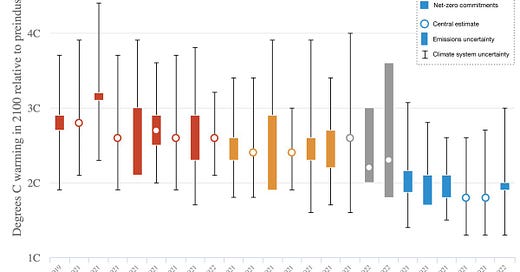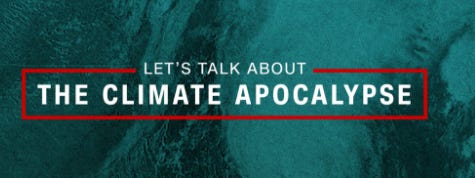Welcome to post-apocalyptic climate policy
Climate policy is quickly moving into a new phase, and that is good news
In the past weeks I’ve noticed some important events that characterize a common underlying trend:
The chief executive of BMW announced that the company would not cut a single job as it transitions to producing only electric vehicles;
The government of India announced that it would build 10 new nuclear power plants in “fleet mode,” with a goal of 5 years from start to finish;
In the U.S., some states and public utilities are making the case for siting modular nuclear reactors at former coal power plants;
Also in the United States, President Biden announced that he was going back on his 2020 campaign pledge to ban oil and gas drilling on federal lands and will now open additional lands for fossil fuel drilling.
What do these seemingly disparate events around the world have in common? Two things, both important. First, they are individual data points reflecting that a global energy transition is well underway, and that it is set to continue. And second, carbon-free energy technologies of production and consumption are increasing their role in the global economy, but when they are not deploying fast enough — leading to geopolitical or economic consequences — then fossil fuels will quickly fill that gap. It’s like an iron law.
If these are but a few data points, a full pointillist painting can be envisioned in the form of various approaches to modelling the evolution of the global energy system. In the Tweet below, Zeke Hausfather — a climate scientist who works for Stripe, a company seeking to capture and store carbon dioxide from the atmosphere — has usefully summarized a large and growing recent literature on climate projections to 2100. These recent projections are based on updated estimates of where the global energy system is currently and appears to be headed based on current and pledged policies. In the figure, which presents the recent studies by date of publication, you can easily see a downward trend with a central tendency projection of global temperatures in 2100 decreasing from almost 3C in 2100 to less than 2C. It wasn’t so long ago that this central tendency was though to be >3 C, and many, not least the IPCC, believed that such “business as usual” trajectories had us heading for even 4C or 5C. For readers of this newsletter, it won’t be a surprise to learn of the good news that perceptions have changed of the likelihood of the chances of such extreme futures. Even the IPCC has come around to this view.


While not everyone is ready to accept the recent good news on climate, the fact is that the world has now moved into what might be called a “post-apocalyptic climate policy” — that is, a climate policy that is predicated not on millenarian expectations for the end of times, but one that is grounded more realistically and pragmatically in first how to maintain, and second how to accelerate the positive energy system trends now underway.
Of course, a change in perspective can be difficult to accept. We have already seen a range of reactions to our newly understood need for a post-apocalyptic climate policy. I’ve observed a few:
Apocalypse maintenance. Letting go of the end of times as the focus of climate advocacy will be difficult for those who have built careers, politics and personalities upon it. Some hold on to the possibility of apocalypse by emphasizing the uncertainty of the future (merchants of doubt?), such as with respect to future rates emissions. Watch out for those who claim that apocalyptic futures cannot be “ruled out” without first telling you what it even means to “rule out” certain futures. While few now believe that apocalyptic futures are where we are headed, keeping apocalyptic futures as seemingly plausible and in play is a common rhetorical tactic that distracts from more meaningful policy discussions focused on far more likely futures.
Moving the goal posts. Another strategy for keeping the apocalypse alive is simply to redefine when the apocalypse is expected to occur. When a warming 4C or 5C was being promoted as a “business as usual” future, futures with 2 to 3C warming were highlighted as examples of policy success. We can see a clear example of this exact framing in the most recent U.S. National Climate Assessment, which presented an extreme climate scenario (called RCP8.5) as policy failure, with as much as 5.5C warming by 2100. The NCA identified a so-called “mitigation scenario” (called RCP4.5) and presented it as policy success, even though this scenario was projected to “more likely than not” exceed 2C.
Today, with current polices and pledges pointing towards the lower end of 2C to 3C futures (or even less), the threshold for apocalypse has in parallel been defined down. For some, a catastrophic future now occurs at 3C and some are even promoting 2C or even 1.5C as the threshold of catastrophe. For instance, just last month after the release of the latest IPCC report UN Secretary General António Guterres defined the threshold of catastrophe as 2C: “If we continue with more of the same, we can kiss 1.5 goodbye. Even 2 degrees may be out of reach. And that would be catastrophe.” Catastrophe is not what it used to be.
Rooting for policy failure. A third approach to keeping the idea of a future apocalypse alive involves rooting for (or at least promoting) the idea of future policy failure. Of course projections of hopeful climate futures conditioned on future policy implementation are based on an assumption that those future policies will need to be implemented. That is the very nature of scenarios — they help us to understand what we might do to achieve policy goals. But of course, such conditionality has always been the case with scenarios. For instance, the most extreme climate scenarios used to support the notion of a climate apocalypse (such as RCP8.5) were also conditioned on policy implementation — in that case, the assumption that policy makers will intentionally seek to convert all of the world energy to coal. That was never going to happen, and continued decarbonization of he global economy looks far more likely.
So instead of dwelling on the apocalypse, what should we be doing instead? I have three suggestions.
First, we have to move beyond the rhetoric of climate catastrophe. Whatever use it may have served in the past, such rhetoric is now a liability. As time goes by and the threshold of catastrophe is defined down, catastrophists are setting the stage for their own delegitimization. The world is currently at about 1.2C. If 1.5C is the threshold for catastrophe, then we are presently not far away in time when such futures will collide with the real world. Because the IPCC does not actually project apocalyptic futures at 1.5C (or even 2C), when people wake up one day and learn that the scheduled apocalypse did not come to pass, they may start asking some questions. Future climate change poses serious risks, of course, and society manages all manner of risks in global issues — pandemics, geopolitics, agriculture, population, etc. — without turning them into unhelpful millenarian caricatures. Climate change is far too important to be treated unseriously.
Second, we need to double down on what I and colleagues have called oblique climate policy, recognizing that accelerated decarbonization of the global energy systems makes sense for many more reasons than just climate. For instance:
Europe has recently learned that its reliance on fossil fuels from Russia pose significant economic and geopolitical risks. Relying less on fossil fuels and more on carbon-free energy from domestic or partners would dramatically reduce those risks.
We see around the world that price volatility (and overall higher-priced energy) can lead to economic and political disruption. Whether it is the destabilizing effects of higher food prices or the knock-on political effects of higher-priced fuel, it is clear that reliable, cheap energy fosters greater political stability.
Don’t forget, vast populations around the world still lack access to the energy services that you and I enjoy every day. The demand for greater supply of energy will be a continuing feature of global geopolitics and national political agendas. Expanding access to energy services without creating new geopolitical risks, economic volatility or domestic political conflict requires expanding access to reliable and affordable supply. That supply will be fossil fuels unless viable alternatives are readily available at acceptable costs.
Of course, if each of these reasons underpinning a more pragmatic approach to energy policies also has the knock-on effect of accelerating decarbonization of the global economy, then so much the better. A post-apocalyptic climate policy is also one that is more robust. Because it is supported by multiple justifications for action, scary climate futures do not have to carry all the weight. But with more policy complexity that accompanies obliquity, so too comes a need for more diversity in the relevant expertise needed to understand and develop policy alternatives. Maintaining the vision of a climate apocalypse thus isn’t just about how we see the future, it is also about who sits in positions of power providing knowledge in support of shaping that future.
Overall, moving to a post-apocalyptic orientation towards climate policy will be a good thing. It will turn decarbonization from a single-issue focus to a many-issue focus. We have precedent for such a reframing in how a perceived global “population crisis” of the 1960s and 1970s transformed from an issue focused on “overpopulation” to one more focused on seemingly oblique issues, like women’s rights, education, agricultural productivity, democracy and more. Issues related to population remain crucially important in 2022 even thought the apocalyptic framing was left behind. Climate change appears to be following a similar path.





Roger, do you really believe that climate variability is climate change? Do you think that a doubling of atmospheric CO2 from just over 400 ppm to 800 ppm would be a bad thing? Do you really think that carbon capture in the West will offset carbon release by China and India? Do you really think that the massive capital investment in CO2 sequestration is going to yield a positive rate of return for shareholders? Just wondering. Martin.
It looks like The Guardian hasn't gotten the word, Roger. Its headline several days ago: "IPCC report: ‘now or never’ if world is to stave off climate disaster". Putting the words "now or never" in quotes implies that the IPCC actually uses those words in its report. Can somebody tell me whether those words are actually used in the report?